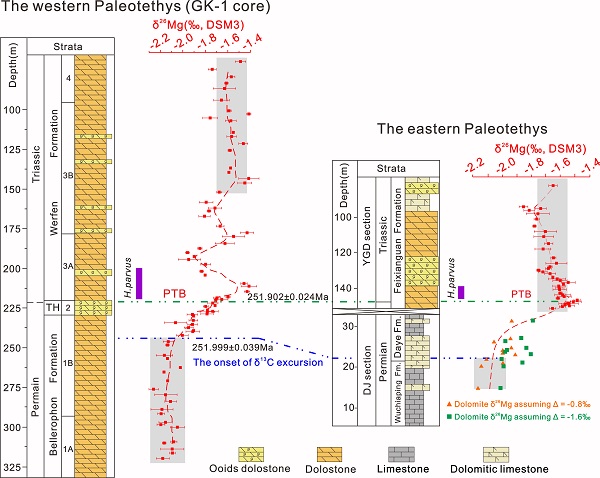The Permian–Triassic transition witnessed the largest mass extinction event in Earth’s history, multiple mechanisms have been proposed to explain the cause of this catastrophe, however, relatively less attention has been paid to the paleogeography and major element chemistry of seawater and its possible link to mass extinction during this interval. Syndepositional massive marine dolostones could record the Mg isotope signature of contemporaneous seawater that hold clues of ancient Mg cycling.
Recently, an international research team from the Nanjing Institute of Geology and Palaeontology, Chinese Academy of Sciences (NIGPAS), Nanjing University and University of Innsbruck investigated Mg isotopes of dolomite from three widely spaced carbonate sections in the Paleotethys to trace oceanic Mg cycling during this critical period. The research results were published in the international journal Earth and Planetary Science Letters.
They found remarkable variation of δ26Mgdolomite values around the End-Permian extinction interval and anti-correlated with global perturbations in δ13Ccarbonate recorded from different localities in the Paleotethys. Generally, the dolomite δ26Mg values displayed a first-order increase from -2.1±0.1‰ at the end Permian to -1.6±0.2‰ in the early Triassic. Based on the high-precision temporal model, our results suggest that the δ26Mg of seawater fluctuated by 0.4‰ within ~750 kyr across the Permian–Triassic transition.
Modeling reveals that the high rate of change in δ26Mgseawater is attributed to dramatically intensified dolomitization in a restricted oceanic environment. The restriction could have occurred to local basins that were separated from each other, however, our data are also consistent with a hypothesis of the Paleotethys Ocean being episodically separated from the Panthalassa Ocean around the Permian-Triassic transition. The restriction events within the Paleotethys Ocean could have significantly weakened the ocean’s buffering capacity against external disturbances, and exacerbated marine environmental crisis to the marine ecosystem.
This work was supported by the Strategic Priority Research Program of Chinese Academy of Sciences, the National Natural Science Foundation of China and the Key Research Program of Frontier Sciences of the Chinese Academy of Sciences.
Reference: Hu, Z., Li, W.*, Zhang, H.*, Krainer, K., Zheng, Q.-f., Xia, Z., Hu, W., Shen, S.-z., 2021. Mg isotope evidence for restriction events within the Paleotethys ocean around the Permian-Triassic transition. Earth and Planetary Science Letters 556, 116704. DOI: 10.1016/j.epsl.2020.116704.

Fig1. Global paleogeography at ~252 Ma and the location of studied sections, Lithological and C-Mg isotopic variations of carbonates along the studied sections in Paleotethys.

Fig2. A comparison dolomite δ26Mg from end Permian to early Triassic for the western and eastern Paleotethys.
Contact:
LIU Yun, Propagandist
Email: yunliu@nigpas.ac.cn
Nanjing Institute of Geology and Palaeontology, Chinese Academy of Sciences
Nanjing, Jiangsu 210008, China
Download:
